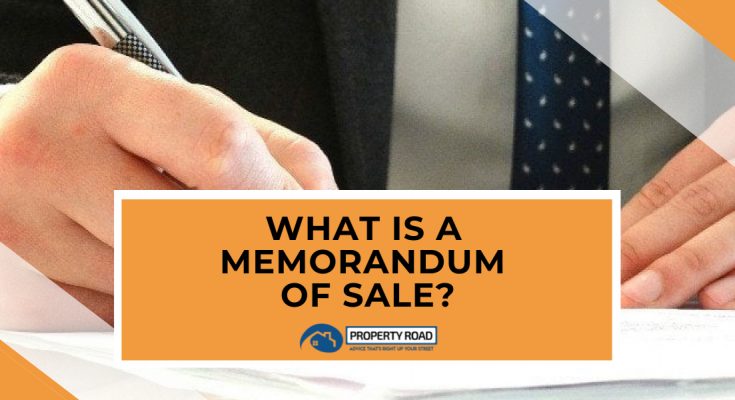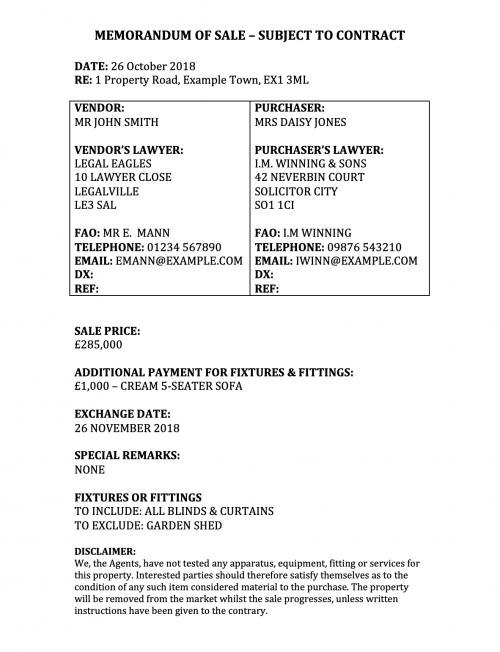If you are in the process of selling a property, you may be asking yourself the question ‘what is a memorandum of sale?’.
This term is often mentioned by estate agents on the assumption you’ll know what it is.
However, it’s perfectly normal to be confused by it. But, fear not as we are about to explain everything you need to know about this important document.
What Is A Memorandum Of Sale In Property?

It’s a document that is created once a sale has been agreed on a property.
It’s not a legally binding document, but it does set out the agreed price and declares the intention of both the buyer and seller to complete the transaction.
It will also show:
- The name and address of both the buyer and the seller
- Details of the solicitors that will be handling the transaction
- Important details about the property the offer has been agreed on
- Which mortgage lender will finance the purchase (if applicable)
It’s, therefore, a record of the sale and purchase that is about to happen (assuming the transaction will complete).
While there are no legal implications to the document, it does seek to clarify and confirm the details of the agreed transaction.
Selling A Property? FREE Step-By-Step Platform
Who Is Responsible For Providing It?
It is usually the sellers’ estate agent that provides the memorandum of sale.
Since the estate agent selling the property is often due a commission when the sale completes, it makes sense that they prepare this important document.
In cases where a sale has been agreed without an estate agent, it would be down to the seller of the property (or a representative of theirs) to issue the sales memorandum.
How Long Does It Take To Get This Document?
This will entirely depend on the estate agent who has been instructed to sell the property.
Typically, it will be prepared within a few days of a sale being agreed. However, it can take longer, especially if one of the parties does not yet have certain details available (such as they are yet to appoint a solicitor).
You may also need to allow extra time for the document to be received in the post since not all estate agents send them via email (though it’s rare, these days!).
We’ve always received a Memorandum of Sale within a few days of agreeing a property sale or purchase. However, as it’s something put together by the selling estate agent, we have found that sometimes you’ll need to chase them for it to get it quicker.
Since your solicitor will need it to start the conveyancing process, it’s important to push to get the document as quickly as possible after a transaction has been agreed.
How Does It Differ From A Notification Of Sale?

Put simply, there is no difference between a memorandum of sale and a notification of sale.
‘Notification of sale’ is simply another name for ‘memorandum of sale’ and the document contains exactly the same information.
It is, therefore, not a legally-binding document. Instead, it’s used for information purposes only.
Who Should Sign A Notification Of Sale?
Both the buyer and the seller of a property would be expected to sign a notice of sale. However, signing the document does not make it legally binding.
The buyer of the property is not required to buy the property (and the seller is not required to sell the property) until the contracts have been exchanged during the conveyancing process.
Therefore, the act of signing the sales memorandum is simply to show that you intend to complete the transaction on the terms stated in the document.
What Does It Need To Include?
The memorandum of sale is simply setting out formally the details of the buyer and seller and the price that has been agreed.
However, it will also include additional information such as details on any fixtures and fittings included in the transaction. It will also state an anticipated date of exchange, though at this early stage it is just a rough agreement.
Both the buyer and seller can choose to add any other specific details they would like the solicitors to be aware of at this stage.
Ultimately, this notice of sale is there to set the legal process in motion and needs to accurately reflect what has been agreed at that point.
What Does A Sales Memorandum Look Like?
A memorandum of sale does not need to look anything special. In fact, most are very plain and concise.
That’s because they only need to convey the correct information clearly. There is no need for anything fancy.
Here’s an example that’s been completed for a fictional transaction:
You can click here to download this example of a completed notification of sale document.
Download A Free Template
Of course, one of the fastest ways to create this document for a property transaction is to download a template.
You can download a free memorandum of sale template we have created by clicking here.
This was created in Microsoft Word and gives you the opportunity to simply fill in the blanks to create your own document.
Remember, the selling agent should provide this document for you. However, if you are not using an estate agent to sell your home, this template will allow you to create a document that provides all of the key information required.
Is A Notice Of Sale Legally Binding?

While it’s an important document that confirms the original agreement of the parties, it is not legally binding. As we have already pointed out.
That’s because, right up until contracts have been exchanged, either party can withdraw from the agreement or change the terms of the deal.
It is better to think of the notification of sale as more of a written record of what was agreed before the legal process began. While not legally binding, it can be useful to refer back to later if there are any disagreements.
What Happens Next?
Once a memorandum of sale has been issued, the sales process can begin.
The selling estate agent will usually change the property to ‘Sold STC’ (the STC stands for ‘Subject To Contract’) and copies of the agreement of sale document are sent to the buying and selling solicitors.
They will then use this to draw up the legal contract along with the other information provided by you and the buyer/seller.
The buyer’s solicitor will then review all the information received and send any enquiries they have to the seller’s solicitor. Depending on how complex the sale is, this process can take a few weeks.
Searches will also be ordered by the buyer’s solicitor and then reviewed. If any concerns have been brought up by the searches, another set of enquiries will be sent to the seller’s solicitor.
Only if all enquiries have been answered and the buyer’s solicitor/buyer is happy, will the sale move to the next stage. This means the solicitors will agree on a date to exchange contracts and a completion date.
Only after contracts have been exchanged is the transaction legally binding. Any withdrawal after this point would incur costs for the party wanting to pull out. This means there are no guarantees until this point.
Things Can Still Go Wrong

As we have already said, the notice of sale isn’t a legally binding document. This means that even once it has been signed and passed on to the solicitors, a lot can go wrong.
In fact, until the point of completion, nothing is guaranteed. On both sides things might change which can lead to the sale falling through.
The seller might get a better offer, which is called gazumping. Especially if it happens at the start of the process, but after the memorandum has been issued, some sellers will decide to accept the new offer instead.
A change of circumstances can also mean that the seller has decided not to sell their home after all. However, more often it’s probably buyers who pull out of the sale. On their side there is more chance of issues occurring.
Bad survey results can lead to the buyer getting cold feet and withdrawing from the sale. Searches can also unearth issues that could put off the buyer.
Issues with funding are another reason, for example, if the mortgage company won’t lend as much as the buyer needs, or the offer expired.
In case of a long chain, the issues could lie further down or further up the chain and causing it to collapse. Sometimes, the buyer might find a better property after the sale was agreed, this is called gazundering.
If the conveyancing process is taking too long, any of the parties involved might get impatient and decide to pull out.
As you can see, just because the memorandum of sale was issued, doesn’t mean that the sale will complete. While this is very frustrating, unfortunately, it’s part of the house buying and selling process.






